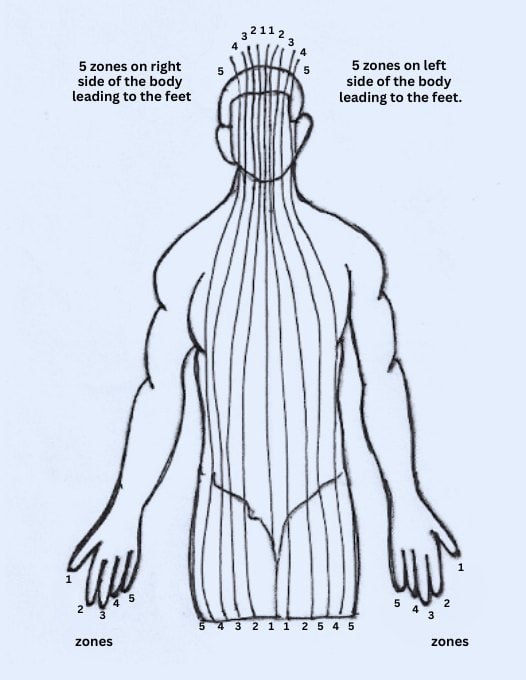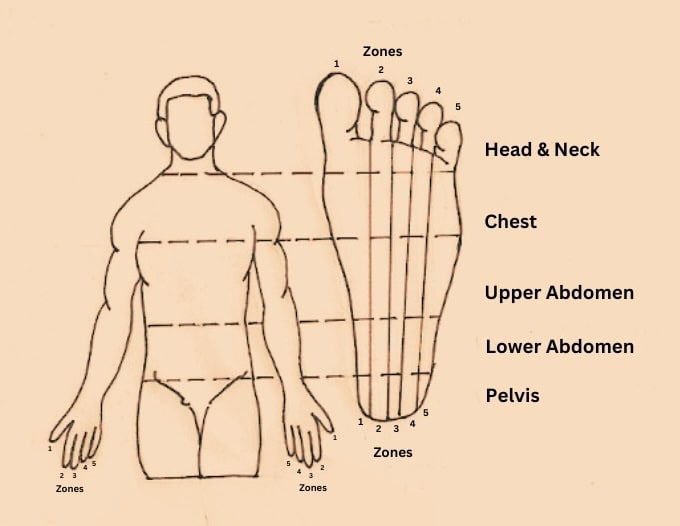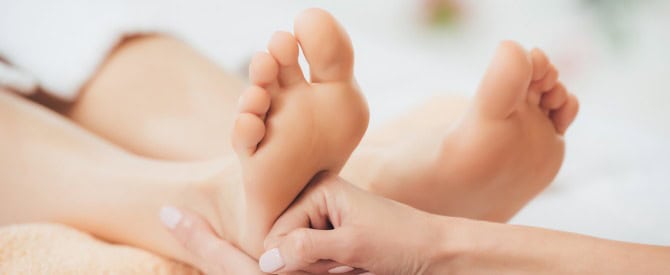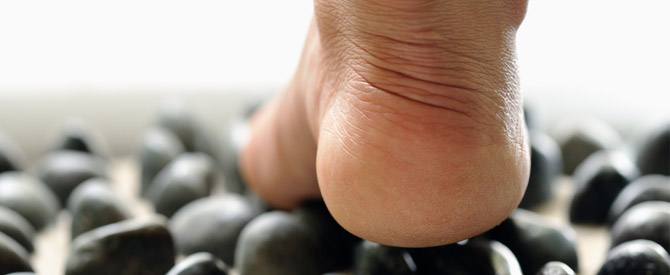Foot reflexology is a form of therapy where we apply manual pressure to specific points on the feet which then activate a response in the areas of the body connected to those points.
Why the feet? What have the feet got to do with the neck, heart, kidneys or thyroid gland, for instance?
The feet are remarkable as there are literally thousands of nerves from various parts of the body that terminate here. By pressing on those terminal points on the feet, the corresponding body parts are activated.
Think of what happens when you ring a doorbell.
When you press the button outside the door, the electrical signal travels through wires to the door chime inside the house which then makes a sound.
Similarly, you can think of the feet as having many “buttons” that convey the signals through the nerves to the corresponding body parts when you press them.
Foot reflexology can help to improve various conditions such as hormonal imbalances, digestive issues, joint pain, back pain, headaches, and is particularly good for relieving stress and promoting the flow of blood and fluids in the body. This latter fact alone can help heal the body of many ailments.
Foot reflexology basics
Before getting into the technique, it’s helpful to first understand some foot reflexology basics.
The functioning of every part of the body is controlled by nerves and is fed by blood that brings nutrients and oxygen, and also removes cellular waste.
The transmission of these nervous signals and the circulation of blood is enabled by the movement of energy in the body. We take in cosmic energy (prana or chi) from our surroundings through our breath.
This energy travels in specific channels in the body and enables physiological functions such as respiration, circulation, digestion, assimilation and excretion.
All body parts, organs, muscles, joints and glands are connected by a network of nerves to small, specific points in the feet where the energy terminates. These terminal points are called reflex points.
A reflex is an automatic response to a stimulus. Applying pressure on a reflex point (stimulating it) triggers an automatic response in another part of the body connected to it.
Here’s an example. My eyes sometimes get tired and become dry from too much screen time. Pressing on the reflex point of the eyes stimulates the relaxation of the eye muscles and the production of tears. I don’t need to apply eye drops.
The body can do this because it has an innate intelligence that knows what to do to achieve balancing and healing. Foot reflexology merely assists the body’s own healing mechanisms.
How do we locate the points on the feet? The placement of the reflex points can be understood better through the foot reflexology zone theory explained below. Once you grasp the fundamentals of this theory, you will be able to locate the general areas on the feet to massage.
Foot reflexology longitudinal zones
 In the early part of the 20th century, an American physician, Dr. William Fitzgerald formulated a zone theory to demonstrate the longitudinal flow of energy and nerve signals from the head to the feet. (See diagram on the right.)
In the early part of the 20th century, an American physician, Dr. William Fitzgerald formulated a zone theory to demonstrate the longitudinal flow of energy and nerve signals from the head to the feet. (See diagram on the right.)
A line is drawn vertically down the centre of the body from the top of the head to the base of the torso.
The body is then divided into 10 zones with 5 zones running down the right side of the body to the right foot, and 5 zones to the left foot.
Zone 1 extends down the centre of the head, face, neck, chest, abdomen, pelvis, and inner side of legs to the right and left big toes.
Zones 2, 3, 4 and 5 run parallel to zone 1 extending outwards from the centre and correspond to the second, third, fourth and fifth toes on each foot respectively.
The hands also mirror the zones in the same way. The thumb is zone 1, and the index, middle, ring and little finger are zones 2, 3, 4 and 5 respectively.
Any blockage, disease and imbalance in any part of the body in a particular zone affects the energy and nerve flow in the whole zone.
Conversely, applying pressure on any part of the zone will clear the blockage in the whole zone.
Based on this premise, we can apply pressure to the reflex points on the feet, hands or any part of the body in the same zone to clear blockage, disease and imbalance in a particular zone,
Foot reflexology is very effective in this regard because the nerve connections to the various body parts are located at the feet and this is also where energy, blood and lymph pools because of the pull of gravity.
This pooling in the feet causes toxins to build up there. These can appear as acid crystals or calcified deposits that feel like sandy or gritty areas during a foot reflexology treatment.
Applying pressure on the feet breaks down and releases the toxins and improves the flow of blood and lymph in the body. This assists the body in healing itself.
Horizontal zones related to the body
 We can also locate the reflex points on the feet by correlating them to general horizontal zones in the body.
We can also locate the reflex points on the feet by correlating them to general horizontal zones in the body.
Looking at the diagram on the right, the toes and the base of each toe relate to the head and neck.
The padded ridge on the foot relates to the chest area where the lungs are.
In the dip of the foot are the organs in the upper abdomen such as the heart, spleen, pancreas, liver, gall bladder, and stomach.
Lower down the dip in the foot, close to the heel are organs such as the small and large intestines, rectum, and bladder.
The heel area relates to the tailbone. The sides of the heel relate to the male and female sexual organs such as the penis, testes, uterus and vagina.
How to locate some foot reflexology points
Using the information shared here so far, let’s try and locate the liver point on the feet. It’s helpful to have a basic knowledge of the organs of the body to do this.
The liver is a large organ located in the right side of the body. If you were to place your right hand sideways just beneath your rib cage, that would be the general area of your liver. Since the liver is big, it would span more than one longitudinal zone. It would cover zone 3, 4 and 5 in the torso and the right foot.
The horizontal placement of the liver reflex point on the right foot is just below the chest area and above the lower abdominal area on the foot. This would be the area to massage the liver point.
The spine is in the centre of the body and so the reflex points of the spine are located along the arch of the feet. The upper vertebrae (cervical vertebrae) are closer to the toes and the rest of the vertebrae (thoracic, lumbar, sacrum and tailbone) follow the curvature of the spine to the heels. Massaging on the spinal points in the feet can help to relieve backaches.
If you have a headache, want to treat or prevent strokes, tune up the brain, the pineal, the hypothalamus or any conditions related to the brain and head, you would massage both big toes. Aside from being in zone 1, the big toes also represent the whole head.
If you had indigestion, heartburn or a feeling of fullness after eating a heavy meal, you could work on the stomach point to relieve these symptoms. Foot massage here will increase blood circulation to the stomach, cause it to secrete more digestive fluids and stimulate the muscles of the stomach to work better.
The stomach is located primarily on the left side of the abdomen but a part of it is also on the right. And so you would massage zone 1 and 2 of the left and right foot just where the dip of the foot occurs.
When I mentioned earlier that I massaged the reflex points for the eyes to relieve dryness and fatigue, I worked on the second and third toes on both feet. This is where the eye points are located because they cover zone 2 and 3 on each side of the head.
The question you may ask is what if you aren’t able to locate the points accurately, would you be causing harm by applying pressure to the wrong area?
You can start by using pain as your guide to find where to massage. Yes, pain. Pain, tenderness or soreness is usually a sign that your body is asking you to help it by massaging the area. So detect those areas and using them as a guide, massage them gently. Spend 1-2 minutes per area.
Applying too much pressure for too long (more than 10 minutes in a particular area) may release more toxins than your body can handle. This may make you feel overly tired, sleepy, nauseous, or headachy. Make sure to drink some water afterwards to help flush those toxins out of the system.
Safe and natural therapy
The body is innately intelligent and knows what to do to protect and heal itself. When injury, illness, stress, a poor diet, lack of exercise or other factors create imbalances and diseases in the body, we can support the body’s balancing and healing mechanisms through foot reflexology massage.
Foot reflexology is a safe and beneficial natural therapy that helps you alleviate symptoms of disease, imbalances and energy blockages. It empowers you to take your health into your own hands!
For more information on my upcoming half-day Fundamentals of Foot Reflexology Workshop, please contact me here.
Like this post? Sign up for the free fortnightly Spiritual Solutions Newsletter and receive the latest articles, news and updates in your email inbox!












